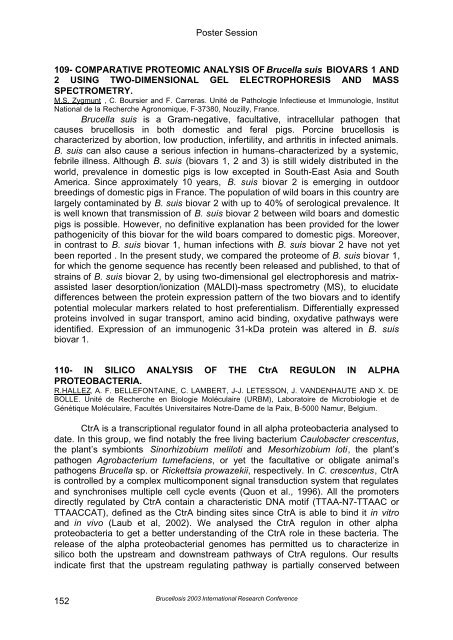Brucellosis 2003 proceedings - PHIDIAS
Brucellosis 2003 proceedings - PHIDIAS
Brucellosis 2003 proceedings - PHIDIAS
You also want an ePaper? Increase the reach of your titles
YUMPU automatically turns print PDFs into web optimized ePapers that Google loves.
Poster Session<br />
109- COMPARATIVE PROTEOMIC ANALYSIS OF Brucella suis BIOVARS 1 AND<br />
2 USING TWO-DIMENSIONAL GEL ELECTROPHORESIS AND MASS<br />
SPECTROMETRY.<br />
M.S. Zygmunt , C. Boursier and F. Carreras. Unité de Pathologie Infectieuse et Immunologie, Institut<br />
National de la Recherche Agronomique, F-37380, Nouzilly, France.<br />
Brucella suis is a Gram-negative, facultative, intracellular pathogen that<br />
causes brucellosis in both domestic and feral pigs. Porcine brucellosis is<br />
characterized by abortion, low production, infertility, and arthritis in infected animals.<br />
B. suis can also cause a serious infection in humans characterized by a systemic,<br />
febrile illness. Although B. suis (biovars 1, 2 and 3) is still widely distributed in the<br />
world, prevalence in domestic pigs is low excepted in South-East Asia and South<br />
America. Since approximately 10 years, B. suis biovar 2 is emerging in outdoor<br />
breedings of domestic pigs in France. The population of wild boars in this country are<br />
largely contaminated by B. suis biovar 2 with up to 40% of serological prevalence. It<br />
is well known that transmission of B. suis biovar 2 between wild boars and domestic<br />
pigs is possible. However, no definitive explanation has been provided for the lower<br />
pathogenicity of this biovar for the wild boars compared to domestic pigs. Moreover,<br />
in contrast to B. suis biovar 1, human infections with B. suis biovar 2 have not yet<br />
been reported . In the present study, we compared the proteome of B. suis biovar 1,<br />
for which the genome sequence has recently been released and published, to that of<br />
strains of B. suis biovar 2, by using two-dimensional gel electrophoresis and matrixassisted<br />
laser desorption/ionization (MALDI)-mass spectrometry (MS), to elucidate<br />
differences between the protein expression pattern of the two biovars and to identify<br />
potential molecular markers related to host preferentialism. Differentially expressed<br />
proteins involved in sugar transport, amino acid binding, oxydative pathways were<br />
identified. Expression of an immunogenic 31-kDa protein was altered in B. suis<br />
biovar 1.<br />
110- IN SILICO ANALYSIS OF THE CtrA REGULON IN ALPHA<br />
PROTEOBACTERIA.<br />
R.HALLEZ, A. F. BELLEFONTAINE, C. LAMBERT, J-J. LETESSON, J. VANDENHAUTE AND X. DE<br />
BOLLE. Unité de Recherche en Biologie Moléculaire (URBM), Laboratoire de Microbiologie et de<br />
Génétique Moléculaire, Facultés Universitaires Notre-Dame de la Paix, B-5000 Namur, Belgium.<br />
CtrA is a transcriptional regulator found in all alpha proteobacteria analysed to<br />
date. In this group, we find notably the free living bacterium Caulobacter crescentus,<br />
the plant’s symbionts Sinorhizobium meliloti and Mesorhizobium loti, the plant’s<br />
pathogen Agrobacterium tumefaciens, or yet the facultative or obligate animal’s<br />
pathogens Brucella sp. or Rickettsia prowazekii, respectively. In C. crescentus, CtrA<br />
is controlled by a complex multicomponent signal transduction system that regulates<br />
and synchronises multiple cell cycle events (Quon et al., 1996). All the promoters<br />
directly regulated by CtrA contain a characteristic DNA motif (TTAA-N7-TTAAC or<br />
TTAACCAT), defined as the CtrA binding sites since CtrA is able to bind it in vitro<br />
and in vivo (Laub et al, 2002). We analysed the CtrA regulon in other alpha<br />
proteobacteria to get a better understanding of the CtrA role in these bacteria. The<br />
release of the alpha proteobacterial genomes has permitted us to characterize in<br />
silico both the upstream and downstream pathways of CtrA regulons. Our results<br />
indicate first that the upstream regulating pathway is partially conserved between<br />
152<br />
<strong>Brucellosis</strong> <strong>2003</strong> International Research Conference
















